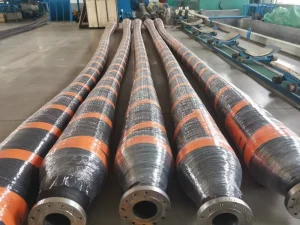Los tifones son habituales en el transporte de energía marina. Los sistemas de amarre de un solo punto y las tuberías en alta mar son equipos críticos para el transporte de energía marina. Jerryborg Marine comparte hoy directrices de seguridad para mantener la estabilidad de estos equipos críticos durante los tifones.
I. Sistema de amarre de punto único
1. Recuerde realizar inspecciones diarias regulares
● Inspeccione periódicamente los componentes clave del sistema de amarre monopunto. Preste especial atención a las boyas, las articulaciones giratorias, las cadenas de anclaje y los componentes de conexión.
● Las juntas giratorias requieren especial atención a su integridad de sellado. Un sellado correcto es fundamental para evitar la entrada de agua de mar.
2. Seguimiento en tiempo real de la evolución del tifón
● Controlar con antelación las previsiones meteorológicas. Comprender la trayectoria, la intensidad y la duración del tifón.
● Ajuste la tensión del sistema de amarre con antelación basándose en la información de alerta de tifón de la oficina meteorológica.
● Compruebe que el sistema de desbloqueo de emergencia funciona correctamente.
3. Ajustar a tiempo el sistema de amarre monopunto
● Evalúe la disposición del sistema de amarre antes de que llegue el tifón. Ajuste puntualmente la longitud y el ángulo de la cadena de anclaje en función de la dirección y la fuerza del viento del tifón.
● Sustituir o actualizar a tiempo los equipos obsoletos.
4. Reforzar la formación del personal y desarrollar planes de respuesta a emergencias
● Organizar simulacros de emergencia por tifón. Asegúrese de que todos los operadores participan en los simulacros para que puedan operar de forma ordenada cuando llegue el tifón. Además, los simulacros de emergencia pueden ayudar a mantener la calma durante condiciones meteorológicas adversas, como los tifones, evitando así el pánico.
● Desarrollar planes detallados de respuesta ante emergencias. El plan debe incluir protocolos de comunicación durante el tifón, procedimientos de corte de energía del sistema y puntos de control de recuperación, entre otros detalles.
II. Mangueras de aceite marinas

1. Inspeccionar periódicamente el estado de las mangueras de aceite marino.
● Realice inspecciones y pruebas periódicas de los tubos de aceite, incluidas pruebas de presión, pruebas de flexión e inspecciones visuales. Sustituya con prontitud cualquier tubo de aceite que se encuentre envejecido o agrietado.
● Preste especial atención a la integridad del sellado de las tuberías de aceite, bridas y válvulas.
2. Preparativos para las mangueras de aceite marinas durante los tifones
● Antes de que llegue un tifón, drene, selle y asegure rápidamente las mangueras de aceite marino. Simultáneamente, cese el transporte de aceite.
● Refuerce previamente las estructuras de soporte de las mangueras de aceite marinas. Esto hará que las mangueras de aceite marinas sean menos propensas a desprenderse y romperse durante un tifón.
3. Sustituir con antelación por mangueras resistentes a los tifones.
Sustituya las mangueras marinas estándar por mangueras resistentes a los tifones que tengan una mayor resistencia a la fatiga. Se pueden añadir dispositivos de protección adicionales al exterior de las mangueras para mejorar su adaptabilidad durante el tiempo de tifón.
4. Establecer un sistema de control
Establecer y utilizar un sistema de control remoto para supervisar continuamente el estado operativo de las mangueras marinas. Los parámetros clave que deben controlarse son la presión, la temperatura y el desplazamiento.
III. Mangueras de aceite marinas Jerryborg
Jerryborg Marine puede ofrecer a sus clientes soluciones personalizadas para el trasvase de combustible marino. Contamos con una amplia experiencia en producción y estamos especializados en la fabricación de mangueras de aceite marinas que cumplen los requisitos de los clientes.
Las mangueras de aceite marinas Jerryborg ofrecen las siguientes ventajas:
Podemos ofrecer una personalización completa. Esto incluye la personalización de carcasas simples o dobles, presión de trabajo, longitud y diámetro, entre otras especificaciones.
Jerryborg Marine dispone de su propio laboratorio de pruebas. Podemos realizar pruebas exhaustivas tanto de las materias primas como del rendimiento específico de las mangueras.
Certificación internacional. Las mangueras de aceite marinas Jerryborg se desarrollan y fabrican de acuerdo con las normas internacionales y cumplen los estándares internacionales. Además, podemos realizar otras pruebas en fábrica según los requisitos del cliente.
Jerryborg Marine cuenta con un centro de producción de caucho y una línea de producción de mangueras de caucho totalmente automatizados. Desde los materiales hasta los productos acabados, podemos controlar totalmente la calidad a lo largo de todo el proceso.
IV. Resumen
Los tifones afectan directamente al nivel de riesgo de las operaciones en alta mar. Los sistemas de amarre de punto único y las mangueras marinas son equipos críticos para las operaciones en alta mar. Debemos prestar especial atención a la seguridad de estos dos equipos. Hoy hemos compartido diferentes precauciones de seguridad para estos dos equipos. Si se produce un tifón, deben aplicarse estrictamente todas las medidas preventivas para garantizar que las operaciones en alta mar puedan continuar con normalidad incluso en condiciones meteorológicas extremas.
